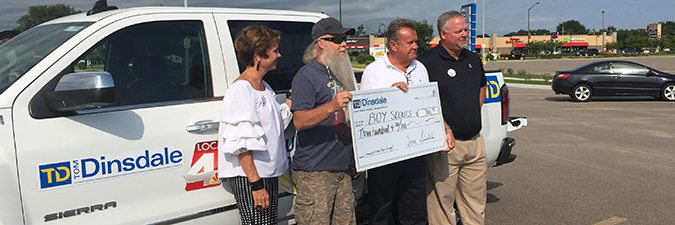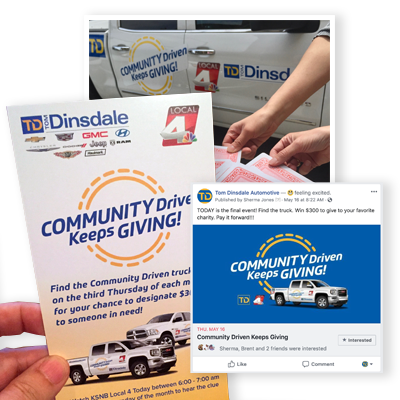Campaign for a Cause
Better your community — and your bottom line — with cause marketing.

What’s the value of doing good?
That’s not a trick question — or a philosophical one.
It’s the question your business should be asking.
We’ve entered the age of the “socially conscious” consumer. An entire segment of spenders is looking to do business with companies that “give back,” companies that “do good.”
Check out these numbers:
Two thirds (66%) of consumers around the world say they prefer to buy products and services from companies that have implemented programs to give back to society. Nearly half (46%) say they are willing to pay extra for products and services from these companies.
A Sample Cause Marketing Campaign: Tom Dinsdale Automotive
IdeaBank Marketing developed a yearlong cause marketing campaign for Tom Dinsdale Automotive in Grand Island and Hastings called Community Driven Keeps Giving. Every month, $300 was donated to a local charity or individual in need.
As part of the campaign, KSNB Local4 gave out clues to help viewers determine where the Community Driven Keeps Giving truck would appear at 10 a.m. that day. The program took place on the third Thursday of each month from June 2018 to May 2019.
Those who found the truck could draw a card for the chance to designate $300 to a worthy cause or individual of their choosing.
While helping the community, Tom Dinsdale Automotive benefitted in a number of ways:
- Inclusion in the Local4 news segments
- Postings on social media before and after each month’s event
- Chatter and goodwill in both Grand Island and Hastings throughout the campaign
As demonstrated, supporting charitable causes is not only good for your community but can boost your business, as well. Here are three steps for executing a meaningful cause marketing campaign.
1. Focus Your Efforts
You’re probably already doing cause advertising. You give money to a local charity, and they put your logo on a T-shirt or in an event program.
It’s simple and straightforward, but the impact is brief and forgettable.
Forging a long-term relationship with one organization is one approach to making a large, lasting impact. The trouble is, of course, which organization do you choose?
Start by looking for a partner that matches your company’s mission and values. For instance, if you’re a sporting goods store, it makes sense to partner with local youth sports leagues. A construction company or hardware store could find a match with Habitat for Humanity.
Working for a relevant cause will be viewed as more sincere by your audience. It’s important that people see you truly support the cause and realize you’re not just in it to look like you care.
Tom Dinsdale Automotive partnered with Local4 TV to create a cause marketing campaign that let the public choose the charity each month.
2. Start Small
Once you’ve chosen your cause, it’s time to amp up your involvement.
Get your co-workers on board. You’re going to be asking for their time, skills and even dollars. Support for the cause and an understanding of the goal — from leadership on down — are key.
After you’ve rallied the troops, get your people involved on a personal level. Encourage leadership to join your partner’s board of directors or serve on a committee. Give employees the opportunity to volunteer, or create a group volunteer outing.
Financially, set your sights on the top sponsorship and donor levels. If you want to build a strong association with your partner, you need to have a leading presence in their efforts. Institute an employer-match program to spur contributions from your employees.
3. Go Big
Your employees are invested and the partnership has been cemented. Now you’re ready to make a splash.
Take the lead campaigning for your cause. Organize your own event or fundraiser, inviting your clients or customers to come and support your cause.
Community Driven Keeps Giving gave potential customers a chance to participate in a fun way each month. The gatherings around the Keeps Giving pickup involved an element of mystery and the luck of the draw, as well as charitable giving.
Another approach is to donate a portion of your sales to the cause. Even if it’s a time-sensitive or product-specific offer, you may be able to boost sales and raise some money for your nonprofit partner.
Finally, integrate your cause into your advertising; highlight the impact your work has made or continue the campaign for financial and volunteer support. This is where buy-in from leadership is crucial. Dedicating a portion of your advertising budget to your cause — rather than your sales message — takes devotion.

From rack cards to social media posts, the Community Driven Keeps Giving Campaign gave employees several ways to share the program.
We also designed and developed a landing page for the campaign, which we featured on DinsdaleAuto.com.
THE HURDLES
Clearly, a cause campaign isn’t the end-all of marketing plans, or everyone would be doing it. Here are three things that can stop a cause campaign in its tracks:
Lack of Buy-In
Budgets are tight, and businesses are strapped for time and resources. Your management may decide that a social cause is not be the best way to invest either.
Local Politics
Focusing your efforts on one organization might not be possible. Existing relationships may keep you from favoring one organization. Business owners often choose to spread their financial support throughout the community.
The campaign for Tom Dinsdale Automotive resolved this issue by allowing the public — in the person of the monthly card-draw winner — to choose the cause or individual to benefit.
Exposure and Consistency
These can be the downfall of any type of marketing effort. Not having a consistent message or the budget to generate enough exposure can hinder results and lessen impact.
While it requires a high level of commitment, a successful cause campaign can build deeper relationships with customers, increase profits and make a lasting impact for an organization and in your community.
That’s the value of doing good.